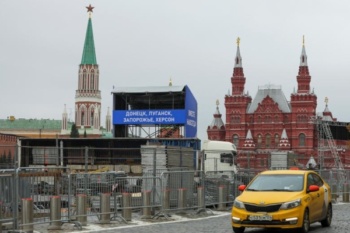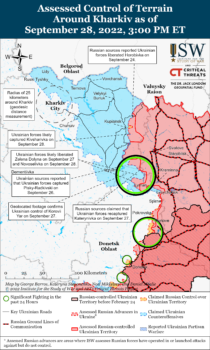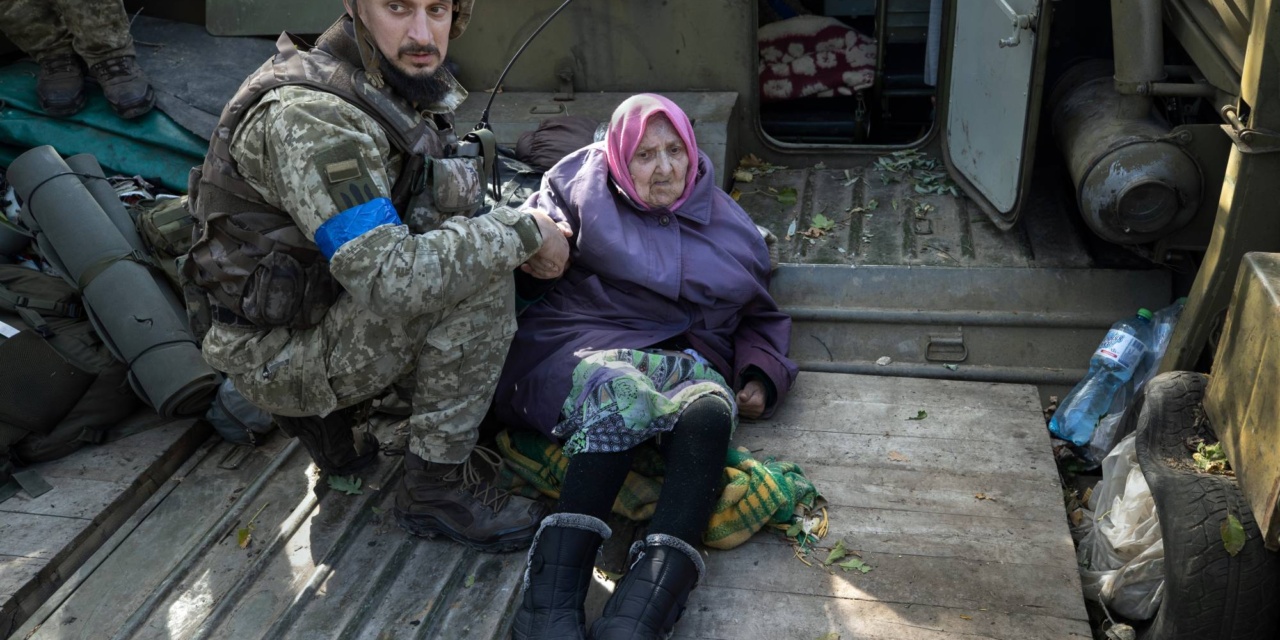A Ukrainian soldier helps an elderly woman flee a village near the city of Lyman, in eastern Ukraine, September 22, 2022 (Tyler Hicks/The New York Times)
Wednesday’s Coverage: Denunciation of Russia’s Annexation “Referenda” in Occupied Areas

Source: Institute for the Study of War
UPDATE 1608 GMT:
A video, posted by Mark Krutov of Radio Free Europe/Radio Liberty, highlights the problems with Vladimir Putin’s “mobilization”.
Men are conversing in the village of Poroshino in the Sverdlovskaya region in western Russia:
We’re mobilized people. We were brought there and dropped in the field. There’s nothing here, we’re building a fire. I’m a senior reserve lieutenant of the medical service. Nobody was waiting for us. They promise [some developments] the next morning.
They didn’t give us a tent or even a stove. Our bus is gone. No one needs us. We didn’t receive dry rations, either. They didn’t pay us our enlistment bonus. We’re self-organizing now, electing superiors among ourselves.
UPDATE 1154 GMT:
NATO has issued a statement about the four leaks from the Nord Stream 1 and Nord Stream 2 gas pipelines in international waters near Sweden and Denmark.
All currently available information indicates that this is the result of deliberate, reckless, and irresponsible acts of sabotage.
These leaks are causing risks to shipping and substantial environmental damage. We support the investigations underway to determine the origin of the damage.
The sabotage of the Nordstream pipelines is of deep concern. #NATO is committed to deter and defend against hybrid attacks. Any deliberate attack against Allies’ critical infrastructure would be met with a united and determined response. https://t.co/XSiqWK20xF
— Jens Stoltenberg (@jensstoltenberg) September 29, 2022
UPDATE 1148 GMT:
Finland is closing its border to Russian tourists from midnight (2100 GMT) after an influx because of Vladimir Putin’s “partial mobilization”.
Entry for family visits, work, and studies is still allowed.
UPDATE 1032 GMT:
Kremlin spokesperson Dmitry Peskov has confirmed that Vladimir Putin will sign a decree annexing four Russian-occupied regions of Ukraine in a Friday ceremony at 3 pm (1200 GMT) Moscow time.
It is the largest forcible annexation in Europe since World War II. The area of more than 90,000 square km (34,750 miles), 15% of Ukraine, is the size of Hungary or Portugal.
UPDATE 0944 GMT:
The Kremlin may be preparing for a formal announcement by Vladimir Putin on Friday, declaring the annexation of occupied areas of eastern and southern Ukraine.
Video screens and billboards are being installed in Moscow’s Red Square, and Russian proxy leaders have arrived in the capital (see 0732 GMT).
Now deputies of the Duma, the lower house of the Russian parliament, have been invited “to the Kremlin for an event on 30 September with the participation of Russian President Vladimir Putin”.
Deputy Denis Parfyonov said the event will start at 3pm Moscow time (1200 GMT).
UPDATE 0750 GMT:
The latest Russian attacks across the Donetsk region have killed six civilians and injured four.
Governor Pavlo Kyrylenko said two civilians were slain in Toretsk and one each in Bakhmut, Pivnichne, Blahodatne, and Mykolaivka.
In the Dnipropetrovsk region in southern Ukraine, Russian shelling killed three people, including a child, and injuring five, including a 12-year-old girl. Rescuers continue to search for bodies under rubble.
UPDATE 0732 GMT:
Sweden’s Coast Guard has discovered a fourth gas leak from the damaged Nord Stream 1 and Nord Stream 2 pipelines.
Two of the four leaks are in Sweden’s exclusive economic zone, and two are in Denmark’s.
Swedish, Danish, and European Union leaders believed the pipelines, which run from Russia to Germany, were sabotaged.
Danish Foreign Minister Jeppe Kofod said on UK television this morning:
It has been clear for us for a long time in Denmark, and also now for the rest of Europe, that we need to get out of any dependence on Russian energy, whether it’s gas, coal or oil, and we’re working very hard to obtain that objective in Europe.
Moscow has denied responsibility for any sabotage, amid Vladimir Putin’s threats to cut off all oil and gas supplies to Europe. The Foreign Ministry insisted on Thursday morning that the “incident on the Nord Stream occurred in a zone controlled by American intelligence”.
UPDATE 0722 GMT:
The US is more than doubling the number of HIMARS medium-range rocket systems sent to Ukraine — but the process could take years.
The US delivered 16 HIMARS to Ukraine this summer. The systems, with a range of up to 50 miles, have been instrumental in checking Russian advances and then enable Ukrainian counter-offensives in the east and south. They have eroded Russian capability through strikes on bridges, ammunition depots, and logistics and supply positions.
Another 18 systems will be despatched as as part of a $1.1 billion military aid package. However, a senior Pentagon official said that they will be newly-procured rather than taken from existing stockpiles, meaning it could “take a few years” before they are on the battlefield.
The latest US package also includes 150 armored vehicles, 150 tactical vehicles for towing weapons, trucks and trailers, and systems to help Ukraine defend against Russia’s Iranian-made drones.
The US has now committed $16.2 billion in military aid to Ukraine during the Russian invasion.
UPDATE 0709 GMT:
The Kremlin appears to be preparing for the formal announcement of the annexation of occupied areas of Ukraine, with a ceremony in Moscow’s Red Square.
Large video screens have been set up. Billboards shout “Donetsk, Luhansk, Zaporizhzhia, Kherson – Russia!”

Photo: Evgenia Novozhenina/Reuters
Leaders of the Russian proxy areas landed in Moscow on Thursday.
The leaders issued a statement alongside a photograph of them on the runway, “The historic plane with the leaders of the liberated territories landed in Moscow. We will become new subjects of the Russian Federation very soon.”
Staged “referenda” ended in the regions in east and south Ukraine on Tuesday, with Russia proclaiming that more than 95% of voters supported Moscow’s takeover.
The Russian Parliament is expected to convene on Tuesday, when Vladimir Putin could declare annexation.
ORIGINAL ENTRY: The Ukrainian counter-offensive in the east of the country is closing on the key city of Lyman.
The Zelenskiy Government and its military are maintaining operational secrecy over the counter-offensive, which liberated more than 8,000 square km (3,088 square miles) in the Kharkiv region in its first week in early September.
However, Russian military personnel are discussing the Ukrainian gains around Lyman in the Donetsk region, a railroad hub southeast of Kharkiv city, with increased concern. They noted advances to the west, north, and northeast, threatening the encirclement of Russian forces in the city and along the northern bank of the Siverskyi Donets River

Ukraine’s liberation of the Lyman pocket would open the way to attacks on Russian occupiers in the northern Donetsk and western Luhansk regions.
That would jeopardize Russia’s gains in its offensive between April and July, when the invaders seized all of Luhansk.
Ukrainian troops have entered Luhansk in the past weeks, capturing the village of Bilohorivka, and could soon put pressure on Lysychansk and Sieveriodonetsk — the last two major cities overrun by the Russians in June-July.
The US-based Institute for the Study of War foresees further Ukrainian victories if they regain Lyman, as Russia’s Defense Ministry “has not addressed current Russian losses around Lyman or prepared for the collapse of this sector of the frontline, which will likely further reduce already-low Russian morale”.
Last week Vladimir Putin responded to the Ukrainian advance by ordering a “partial mobilization”, but its chaotic implementation has failed to alter the battlefield and has provoked widespread discontent inside Russia. Analysts say that even if Moscow can call up hundreds of thousands of men, it is unlikely to regain the initiative given long-term issues with supply, logistics, command, and morale.
See also EA on International Media: Putin’s Desperation Over His Failing Ukraine Invasion
The ISW notes, “Russian authorities continue to send newly-mobilized and undertrained recruits to directly reinforce severely degraded remnants of various units, including units that were previously considered to be Russia’s premier conventional fighting forces.”

